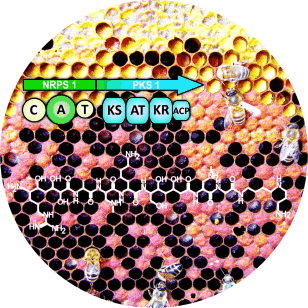Credit: Wiley-VCH
Infections with American foulbrood can destroy entire bee populations. A team of German and Dutch researchers has now isolated metabolic products of the pathogen that causes it, Paenibacillus larvae. The structures of the products have been identified, providing insights into the unusual biosynthetic pathways by which they are made. These new findings could help to clarify the mechanisms of infection and thus to find points of attack for effectively combating bee disease. As the researchers report in the journal Angewandte Chemie, these paenilamicins have antibiotic effects that may also be of use in human medicine.
The honey bee is one of the most important pollinators in our agricultural and subnatural ecosystems. Our supply with fruit, nuts, and vegetables depends significantly on the fact that enough honey bees fly to the flowers of these plants. In recent years, pesticides and other environmental factors have posed massive health threads to bees. Infectious diseases can cause the death of bee populations. The American foulbrood of bees is a frequently encountered notifiable animal disease which causes infected larvae to essentially disintegrate.
Currently, not enough is known about the molecular mechanisms of the infection to effectively combat this disease. A team at the Technical University of Berlin, the Institute for Bee Research in Hohen Neuendorf, and the University of Leiden (Netherlands) has now gained some new insights: The genome of the pathogen contains genes for an interesting class of natural compounds, peptide-polyketide hybrids with antibacterial and antimycotic effects. The researchers found the special biosynthetic pathways for the formation of these metabolites, which does not use ribosomes, to be fascinating.
The team headed by Roderich Süssmuth and Elke Genersch was able to isolate several of these paenilamicins. They were then able to determine their structures and to characterize their amazing bioactivity: The bacteria release these compounds after they have infected bee larvae in order to keep competitors at bay. Paenibacillus larvae thus effectively kills off the bacterium Paenibacillus alvei in the intestines of the larvae, for example.
The scientists hope that their new insights into the paenilamicins and their biosynthetic pathways will lead to new approaches for combating foulbrood. In addition, the antibiotic effects of these substances could be a starting point for the development of novel human and veterinary pharmaceuticals.
More information: Müller, S., Garcia-Gonzalez, E., Mainz, A., Hertlein, G., Heid, N. C., Mösker, E., van den Elst, H., Overkleeft, H. S., Genersch, E. and Süssmuth, R. D. (2014), Paenilamicin: "Structure and Biosynthesis of a Hybrid Nonribosomal Peptide/Polyketide Antibiotic from the Bee Pathogen Paenibacillus larvae." Angew. Chem. Int. Ed.. DOI: 10.1002/anie.201404572
Journal information: Angewandte Chemie , Angewandte Chemie International Edition
Provided by Angewandte Chemie






















